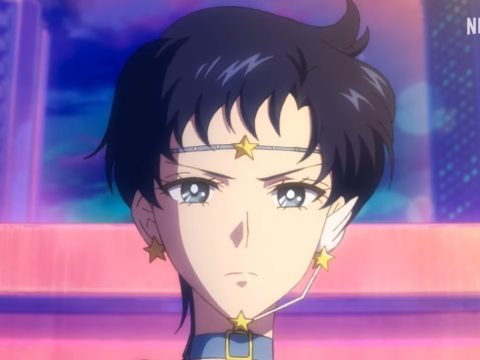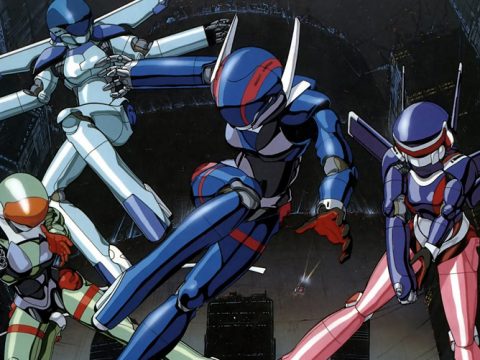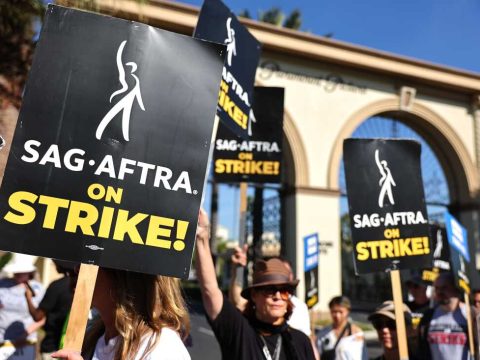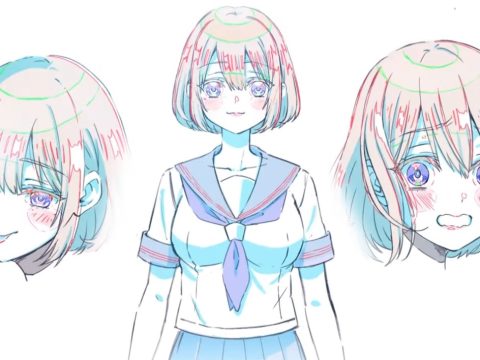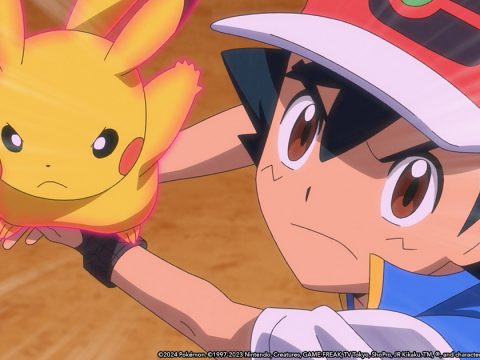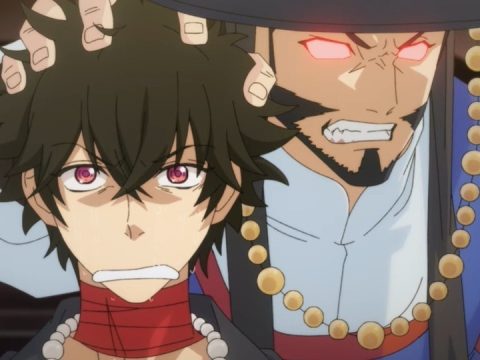It’s a good time to be an OEL manga artist. Fred Gallagher’s Megatokyo has been licensed for publication in Japan, one of the first manga-influenced American comics to be so honored. Japanese Foreign Minister Taro Aso intends to promote otaku culture worldwide, and in May 2007 he announced the first International Manga Award, which was won by Audtralian artist Madeleine Rosca’s Hollow Fields. Japan has become aware of foreign otaku, not just the ones swarming around Akihabara buying toys, but the ones drawing up a storm in college dorms and parents’ houses across America. And the verdict is in:
Japan likes it.
Of the many Japanese publishers, none has courted foreign artists as much as Kodansha, Del Rey’s No. 1 licensor and publishers of Weekly Morning and Weekly Shonen Magazine. Way back  in the early 90s, Kodansha exhibited at Comic Con, handing out a pamphlet called Manga Surprise! and doing portfolio reviews of American talent. One artist, Paul Pope (THB, Batman: Year 100) was invited to Japan to learn the Way of Manga from Japan’s best editors. Pope’s project went on hold for many years, but now it’s back. In December of 2006 Kodansha announced the Morning International Competition, and this August, the winners were announced. The contest is a success, and the International Manga Competition will continue twice a year. If you’re French, Chinese, Korean, German, Italian, Spanish, Thai, or English – this is the biggest open invitation from a Japanese publisher … ever.
in the early 90s, Kodansha exhibited at Comic Con, handing out a pamphlet called Manga Surprise! and doing portfolio reviews of American talent. One artist, Paul Pope (THB, Batman: Year 100) was invited to Japan to learn the Way of Manga from Japan’s best editors. Pope’s project went on hold for many years, but now it’s back. In December of 2006 Kodansha announced the Morning International Competition, and this August, the winners were announced. The contest is a success, and the International Manga Competition will continue twice a year. If you’re French, Chinese, Korean, German, Italian, Spanish, Thai, or English – this is the biggest open invitation from a Japanese publisher … ever.
Why does one of Japan’s biggest publishers look to America? What do they want? And how can you submit? We asked Eijiro Shimada, the Kodansha editor in charge of the project. Shimada has worked on many Morning series, including Kazumi Yamashita’s Fushigi Na Shonen (“Wonder Boy”), Shuho Sato’s Black Jack ni Yoroshiku (“Say Hello to Black Jack”), and the Chinese historical epic Sotenkoro by King Gonta and Korean artist Hagin Yi.
 JASON THOMPSON: How did you become an editor at Kodansha?
JASON THOMPSON: How did you become an editor at Kodansha?
EIJIRO SHIMADA: I was a political economics major at Waseda University, and I applied to Kodansha for a job. I didn’t specifically apply to be an editor, but I ended up being chosen to work for Shukan Gendai (Weekly Gendai, a magazine). I worked on Shukan Gendai two years, and after that I was transferred over to Morning.
What was your background in manga prior to working as an editor?
I knew as much as the average Japanese person. When I was a kid I read shonen magazines – Jump, Magazine, Sunday. But I was never a hardcore fan. I had to learn to be an editor through on-the-job training.
How many of the editors come from a non-manga background like you, and how many come from a manga background?
There are two types of editors in the Kodansha editorial department…people who have general knowledge, and editors who are specialized in manga. Nowadays people are getting more specialized, but when I applied for my job about 20 years ago, the former type was more common.
It was similar for me…when I got my job at VIZ they were more impressed by the fact that I was an English major than that I was a manga fan. So what manga series did you first work on?
The first artist I worked with was Seizo Watase, on Heat Cocktail. When junior editors start working in the editorial department, a senior editor will pass a pre-existing artist and series on to them. Junior editors become full-fledged editors when they are able to start up a successful new series. On average, it takes about three years. In the meantime, they are always on the lookout for new series. One of their jobs is to go through the contest submissions and pick up new artists and work with them.
 Tell me a little about the readership of Morning. It’s a seinen (men’s) magazine, but it seems to be written for both men and women. What is the makeup of Morning readers?
Tell me a little about the readership of Morning. It’s a seinen (men’s) magazine, but it seems to be written for both men and women. What is the makeup of Morning readers?
Technically, it’s a seinen magazine, but we have a good number of female readers. The readership is 60% male, 40% female. But many of the female readers are wives who read the copies that their husbands bring home, and so forth.
One of the interesting things about Morning is that it seems aimed at mainstream audiences … the stories have the same kinds of subject matter as prime-time TV. How do you specifically create manga for this audience?
Well, we don’t think of our manga as “mainstream,” in the sense that popular shonen and shojo manga are mainstream. We think of it as being for general audiences, for people who aren’t manga fans, or haven’t read manga before. Unlike shonen magazines, it has a lower circulation, because it’s seinen. But it can have a greater influence in society. When there’s a hit manga in Morning, it can really cause a change in society. Like Section Chief Kosaku Shima … it made people think, “Oh wow, even salarymen can read manga.”
In the early 80s, when Morning first appeared, it seemed to be part of a trend for manga for general audiences, like Big Comic. But in the past 10 years, it seems that all of the new manga magazines have been aimed at otaku. It seems like the market has been breaking up into niches. Is there less demand for manga for general audiences?
It’s true what you say, about the market breaking up into niches … perhaps what’s happened is that manga for general audiences has become a niche in itself. Back in the 80s, it was very hard to imagine people like bosozoku gang members or yakuza reading moe manga, but now, even the foreign minister (Taro Aso) is reading manga.  (laughs) So it’s more accepted to be an otaku, What was once a hidden niche is now one of the more prominent niches.
(laughs) So it’s more accepted to be an otaku, What was once a hidden niche is now one of the more prominent niches.
In Morning, do you try to keep a particular balance of stories? For instance, if a Fuyumi Soryo science fiction manga has ended, do you try to find another science fiction manga to replace it with?
Generally we don’t think about balance … but I guess as we edit certain titles, it ends up being balanced. We just try to print good manga.
Tell me about the International Manga Competition. Does your announcement of the competition have anything to do with Taro Aso’s International Manga Award?
There’s no connection. It just happened that it came around the same time. We announced our contest around the end of 2006, and the International Manga Award wasn’t officially proposed until May 2007.
Kodansha has a history of seeking internernational artists. In 1993 Tony Luke and Alan Grant’s Dominator was published in Afternoon magazine. And then in 1995 Kodansha exhibited at San Diego Comic Con and gave out the Manga Surprise pamplet…
You read Manga Surprise?
 Yep. And then around 1996-1997 you worked with American artists like Paul Pope, Garret Izumi, and Tom Hart…is the International Manga Competition a continuation of these efforts?
Yep. And then around 1996-1997 you worked with American artists like Paul Pope, Garret Izumi, and Tom Hart…is the International Manga Competition a continuation of these efforts?
Yes, it is, although there was more than a 10-year gap. Morning’s first chief editor, who worked there for over 15 years, was very interested in international comics and in finding foreign artists. But frankly, although it wasn’t expected to make a lot of money, no one expected that it would be quite such a huge loss. So that’s why the whole project was put on hiatus. Morning was suffering in sales, so we had to stop. I’m the last editor from that period who’s still around. The International Manga Competition came just in time to rekindle my desire to find foreign artists.
What do the international artists have today that they didn’t have 10 years ago?
Well, what’s happened is that manga and anime have become so popular in America that it’s second nature for the new generation of artists. In the past, a lot of American and European artists were drawing “comics” not manga. It was interesting in some ways because it was foreign, but basically it wasn’t manga. We had to explain manga to them. But now, manga is more accepted abroad. It’s easier to coordinate things like manga style – how to draw the panels, how to build the story, and so on.
In an interview in Pulp Vol. 5 #8, Paul Pope talked about his experiences working with Kodansha. And he said he greatly appreciated the time he spent training with Kodansha, but that in the end, his work was not quite Japanese enough, and that they hired a Japanese artist whose work was “a little more Japanese.” Would you like to comment on this? Do you feel that a native artist will always be more suited to Japanese audiences than a foreign artist?
I think the difference between Paul Pope and the new generation of American manga artists is that Paul Pope didn’t grow up reading manga and watching anime. The new artists are so familiar with Japanese styles, it’s almost like they’re Japanese artists.
 So what do these new artists have? The right art style, the knowledge of manga, the right attitude?
So what do these new artists have? The right art style, the knowledge of manga, the right attitude?
Everything.
So what is manga? Apart from the character designs, what is the most essential element?
The most important element of manga is character. American comics focus on story, but in manga, it is the appeal of the character that draws readers.
That brings up an interesting point. In manga such as Section Chief Kosaku Shima and Golgo 13, the character is the center of the manga, but there is no real ongoing story … the plots are episodic, there is no ending. In that way it’s similar to American comics like Spider-Man. But obviously many manga are stories with endings. What is more manga-like? What is the proper balance between story and character?
It’s true that in the early days of manga, there were many manga like Kosaku Shima and Golgo 13, which were totally centered on the main character. But even in story-focused manga like Naoki Urasawa’s Monster and 21st Century Boys, in every chapter the creator makes sure to focus on a character – not necessarily the main character -and pull the readers into the story through them. So even though on the surface it’s story-based, it’s really character-based.
In America, there are traditionally two types of comics: superhero
comics, where the editor and the publishing company control everything, and indy comics, such as Frank Miller and Fred Gallagher, where the artist controls everything. Where does Japan fall on this scale?
Right in between. The editor and the artist are on the same level. A new editor will try to establish the artist, try to start up a new series. To use an analogy, for each chapter, the editor must drop the stone down a deep hole. It takes courage for the editor to drop that stone, and it takes courage for the artist to jump into that hole and find that stone. In fact, the editor will take the artist’s hand and they’ll jump in together. If it’s a weekly series, they need to throw that stone and pull it out, week after week.
 So does the editor actually write the story, or is it a collaboration?
So does the editor actually write the story, or is it a collaboration?
Hmm … I can’t think of any cases where the editor actually writes the story … that’s a very extreme case. It depends on the story. Sometimes the artist is so seasoned that he or she doesn’t really need the editor other than to help with nonstory stuff. But for the most part it’s a collaboration.
So do you think all artists benefit from working with editors?
Oh, absolutely. A good editor can make artists feel better and help them make better stories. Making them feel better so they can produce faster and more effectively, helping them focus, and guiding them in the right direction.
So, going back to the International Manga Competition … why now?
Why this timing?
One of the factors is that last year was Morning’s 25th anniversary, and there were a lot of campaigns throughout the year – reader surveys, web reports, etc. The International Manga Competition is one of those campaigns. Back in the 90s, we were losing money so we stopped looking at foreign artists, but now we’re doing quite well. It’s a luxury to run a contest like this, and the economic factor is important.
Are you planning to invite any foreign artists to Japan, to train them in how to draw manga, the way you did with Paul Pope?
It don’t think it’s necessary …
the new artists we’re seeing are so close to the manga style that it’s not necessary to train them. Also, compared to back then, it’s easier to coordinate via PDFs and FTP and e-mail.
 Do you think it might be possible to have foreign artists actually work for a Japanese weekly or monthly magazine?
Do you think it might be possible to have foreign artists actually work for a Japanese weekly or monthly magazine?
Well, weekly manga might be difficult … even in Japan there aren’t many artists who can do weekly manga. But I think monthly manga could be possible. Back then, we would be lucky if we could squeeze 30 pages a year out of American or European artists. But now, looking at the productivity of American artists, I think its possible.
What if they miss their deadlines? Will you have to fly to the US to track them down?
(laughs) Not really. They’re productive enough that we should be able to get the pages out of them without a problem.
Will the contest winners’ work be translated into Japanese or kept in the original language?
The first place winner will be translated and published … if it’s successful, it’ll be run in Morning 2 and collected in tankobon editions. If a foreign company wants to license them and translate them back into another language, that might be possible, but we basically want to treat them just like a regular Japanese artist.
In Japan, magazine circulations have been dropping for 10 straight years, but in America and around the world, the popularity of anime and manga is booming. Are international artists a way to bring “new blood” into the Japanese market? What will they bring to the table that Japanese artists don’t?
 We’re looking for a catalyst for changes that could vitalize the manga industry as a whole. It’s not really new blood we’re looking for, but a new idea. I’m looking for the foreignness of these entries, things a Japanese artist can’t even fathom. The art will look very Japanese, but the style, the way the character talks or thinks, could have that certain foreignness that might be what people are looking for… I want the artist to send in entries that will make readers say, “That’s not manga!” But as they read it, they’ll reconsider and think, “Hmm, that could be manga.” The more artists that are out there, the greater possibility of pushing the envelope of what a manga is supposed to be.
We’re looking for a catalyst for changes that could vitalize the manga industry as a whole. It’s not really new blood we’re looking for, but a new idea. I’m looking for the foreignness of these entries, things a Japanese artist can’t even fathom. The art will look very Japanese, but the style, the way the character talks or thinks, could have that certain foreignness that might be what people are looking for… I want the artist to send in entries that will make readers say, “That’s not manga!” But as they read it, they’ll reconsider and think, “Hmm, that could be manga.” The more artists that are out there, the greater possibility of pushing the envelope of what a manga is supposed to be.
So you’re trying to expand the definition of manga … is this also the goal of Morning 2?
Exactly. Seinen (men) are the target audience for the magazine, of course, but that doesn’t restrict it … if it’s a good manga, we’ll put it in there. Japan is an island nation, where manga developed in isolation for many years, but then when you look at Europe and the US, it’s interesting to see how manga evolved on those different continents. Maybe even a different planet. The possibilities are endless. We hope to stimulate these ideas and see them in the contest.
So in closing, what message would you like to give people who are thinking of applying to the International Manga Competition?
The competition is to challenge the definition of manga. Please, American artists, don’t restrict yourselves to a narrow definition of what manga is. Have a wider perspective, and please send us your entries. l
Thanks to Eijiro Shimada for his time. Special thanks to Yukari Shiina for arranging the interview and to Anastasia Moreno for translation. Results of the first Morning International Manga Competition were as follows:
Grand Prize:
Kage no Matsuri by Bikkuri (story) and Rem (art) [America]
2nd Place:
Vefurrin by Hwei-Lin Lim [Malaysia]
3rd Place:
Nigiri Supahero by Liou Ming Law [London]
The Grand Prize entry, Kage no Matsuri (“Festival of Shadows”) was published in Morning 2 #6, on sale now in Japan.


